Come to think of it, raw – and sometimes ripe – mango is one of the very few flexible fruits used in a wide range of savoury dishes across cuisines in India – quite apart from pickles, chutneys and sherbets. The fruit’s tanginess not only adds a zing to the palate, its pulpiness adds to the dish’s texture. And it’s a healthy coolant that one needs to survive Indian summers.
So how do our regional kitchens use the raw avatar of the king of fruits?
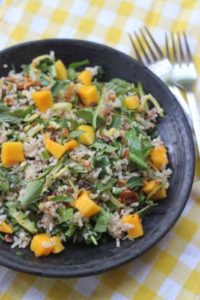 East
East
Bengali summers are synonymous with aam daal – masoor daal tempered with mustard seeds, slightly sauted raw mangoes and ginger paste. It’s food for the soul if you know what I mean.
Method: Chop mango and boil the daal. Heat mustard oil and temper with mustard seeds and dry red chillies. Once the mustard seeds start spluttering, add the mango and saute lightly for a while. Add dal along with some water. Add ginger paste, salt, turmeric, green chillies and stir well. Simmer for 5 minutes. Serve hot with rice.
Another popular preparation is the tangy avatar of the ubiquitous chochhori – a semi-dry mix vegetable curry which gets its summer spin with pulpy raw mangoes. The fruit all but melts into the spicy curry leaving it bursting with flavours.
Move further east, and some hyper-local cuisines of Assam use raw mango in pork and fish dishes, apart from daal.
“Mangoes are not as widely available in the Northeast as in other parts of the country. But when I was growing up, I saw my aunt make pork with raw mango. She used a tadka of paanch phoron (the mix of the five spices cumin, brown mustard, fenugreek, nigella and fennel) to cook the pork with ginger-garlic paste, some herbs and slightly boiled mangoes. It’s a dry tangy dish and fattier the pork, the yummier it is! She used to cook it with fish like rohu as well. I try the recipe at home now with minor variations.”
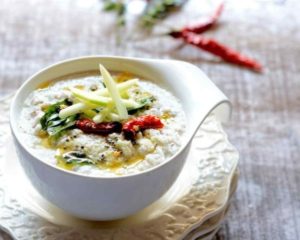 South
South
Down south, raw mangoes often replace the essential tamarind during the hot season to find its way into pachadis, salads and chutneys. Nutritionist and food expert Dr Nandita Iyer, who runs the blog Saffron Trail, often drums up a spicy cold red rice salad with a generous dressing of raw and ripe mangoes and coconut.
Iyer also uses raw mango to give a twist to the coconut chutney. The recipe, featured in her recently released book The Everyday Healthy Vegetarian, involves putting peeled and chopped mangoes in a blender with grated coconut, green chillies, fried gram, ginger, salt and soaked tamarind. Blend well and finish off with a tempering of mustard seeds, urad daal, dry red chillies, curry leaves and a pinch of asafoetida (hing) powder in groundnut oil.
Or if you are planning to serve a raita, Iyer recommends you chop the vadumaanga (whole raw mangoes marinated for 7-8 months or more in brine and chilli powder till they become soft and yum) and mix it with grated coconut in a blender. Mix it with dahi (curd) and give a tadka of mustard seeds, urad daal, curry leaves and small dry red chillies, and voila, your vadumaanga thayir pachadi is ready!
Another Tamilian delight is the mangai mor kuzhambu.
Method: In a thick bottom pan, cook cubed mango with just a little water. Do not over cook as it may become mushy. Add turmeric & a little salt while it cooks. In a blender, combine coconut,green chillies, jeera & soaked rice to make a smooth paste. Take the curd in a vessel & beat it without adding water. Combine the ground paste to the curd and mix well. When the mangoes are cooked, add this curd and coconut mix to it. Add salt as per taste and cook on medium flame. Do not boil it. When it raises up, switch off the gas. In another pan, heat oil & add mustard seeds. When it splutters, add the remaining ingredients for tempering & pour it over the curry. Serve it with rice and papadam.
The lemon rice gets a mango makeover with mavinakayi chitranna in Karnataka, while in Kerala’s Thrissur, the pachmanga meen curry is a mean thing.
“We prepare all fish curries in earthen flat pots called chatti, so that while serving, the delicate fish does not break. We use souring agents like tamarind, kodampulli, kokum, or raw mangoes in all fish curries, depending on the season. Mangoes go very well with the fish.”
“The fish is cooked in a thin coconut milk curry made with onions, curry leaves, green chilies, ginger, coriander, turmeric and chilli powder. It is simmered until the mangoes give off their sourness. Once the fish is cooked, then thick or first pressed coconut milk is poured. After that, curry leaves and finely chopped Madras shallots are quickly fried in coconut nut till dark brown. This tempering is poured over the curry, quickly stirred. Serve hot with rice,” shares Alookaran and recommends you use the Totapuri mango for this one.
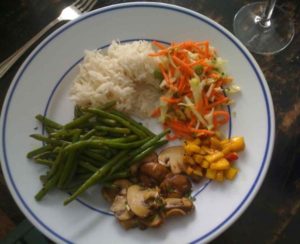 West
West
In Maharashtra, even the pit of the kairi has its uses.
“The stone or pit, with some flesh on it, is used to give tartness to amti (any daal with tamarind, kokum or kairi in it). It is also grated and added to a dish called kairichi daal. This snack is made from soaked, raw chana daal that is coarsely ground and flavoured with grated green mango, fresh coconut, chilies, and coriander. It is served at dohale jevan (baby showers) if they take place when green mangoes are in season. Kairichi daal might also be served as prasad at women’s haldi kunku ceremonies.”
Marathe, who now lives in California, shares how her paternal grandmother used to make a fresh pickle by mixing diced mango with salt, lemon juice, sugar or jaggery, and seasoning it with hot oil tempered with mustard seeds, asafoetida, turmeric and fenugreek seeds. “The pickle is sweet, tart, crunchy, and spicy. It lasts for about a week, if your family will let it!” she says and adds that it often finds itself to her summer menus.
The Pathare Prabhus (PP), one of the original settlers of what was then Bombay, add their own spin to kairi. Dine with Vijaykars, which organises regular PP pop-ups in Mumbai, serves a koshimbir (salad) with raw mango, white onion, coconut, smoked dry Bombil and coriander. Another popular dish is gor kairi, a mango-based sweet and sour curry. The kharavani blends raw (and sometimes ripe) mango with coconut milk, besan and shrimps. A killer combo, this!
While East Indian kitchens often use ripe mango and white onion bulbs to make a prawn curry, it is the Parsis who really put on the adventurous cap when faced with raw mangoes.
“Parsis took to mango farming in a big way – where they settled north of Mumbai and 200km-300km along the Gujarat border, they owned large farms, and mangoes came from there in bulk to Mumbai, thanks to the railways.
A lot of Parsi food have some souring ingredient – kokum, tamarind and raw mango, depending on the season,” says Dr Kurush F Dalal, Assistant Professor of archaeology at University of Mumbai and owner of Katy’s Kitchen.
Using raw mangoes in food came as a natural progression to using the crop optimally – mangoes have the tendency to fall before ripening or sometimes fruit-laden trees have to be pruned.
“Dhansak daal in summer is always khatti daal made with raw mangoes. It also replaces the traditional tamarind in the typical Parsi fish/ chicken/ mutton curry, made with coconut milk, red chillies and other spices,” says Dalal.
“But the most intriguing preparation is the poro – the Parsi style masala omlette to which loads of finely shredded raw mangoes are added during summer. I remember my grandmother going to the mango tree in the courtyard of her Bandra house at dawn, before the birds woke up, to scoop up a few of the fallen fruits to truss up delicious poro for breakfast!”
In Gujarat, the piquant keri nu shaak is a summer favourite.
“Growing up, Keri nu shaak was a family favourite. Every time the mango season arrived, my mum or maharaj would make a huge, huge batch of it that we would have at meals for the next few days. Definitely one of the top 10 simplest, most delicious dishes I have ever eaten. It’s fab with rotis, parathas or even daal-rice. The best bits are the stones, (or gutli) because they are delicious to suck on!”
Method: Heat oil in a pan. Add mustard seeds, cumin seeds, hing. When the seeds start to crackle, add cut mango pieces. Mix well. Now add red chilli powder, jaggery & salt. Add 1 cup of water & mix well. Cook it on a low flame with the lid covered. Cook till the mangoes are tender & you get a jammy gravy. Garnish with coriander leaves & serve. Serve with rotis or puris.
Aam ki launj is a summer staple in the Marwari cuisine. Cooked with a tempering of fenugreek seeds, fennel seeds, onion seeds, turmeric powder, red chilli powder and grated jaggery, this sweet and sour curry is a must-have.
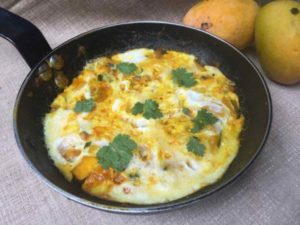 North
North
Ghildiyal shares another little-known delight from Uttarakhand which is all the rage during the hot season. The aamwaani is simplicity itself, where slightly yellowing mangoes are macerated with salt, chilli powder and lemon juice and then squashed into pulp. You can polish off a plate of rice with this one!
In Lucknow, the Awadhi one-pot vegetable rice that is tehri gets a tangy twist during summers with pickled raw mango. There’s also kacche aam ki sabzi, and if you like your non-veg, throwing some raw mangoes into the common chicken curry is quite common in the city of the nawabs.
If you need more proof of the lethal power of the raw mango-Indian kitchen combo, we can assure you there’s much more. But for now, why don’t you rustle up some of these dishes to make the best of this summer crop? Bon appetit! #KhabarLive

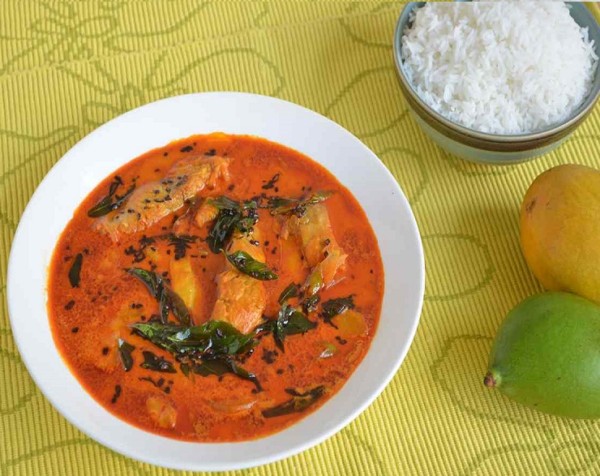






I like that Lacey has been developing her character, I just wish she would go for a tough marine woman instead of the sassy marine woman. Lacey could be something unique with a short cut (even a buzz-cut, like a GI Jane thing) and a more brash style to set her apart, while keeping the prudish stuff (mix of RTC Ivory and heel Molly Holly ). They also need to change her music. Right now, she”s giving me more Charlotte-lite than anything else, but she”s come into her own a lot. Kairi is also great, but she”s directionless at the moment. The fact that she won the MYC and they didn”t really have a plan for her afterwards is somewhat frustrating. With more than one storyline and character development, the division could definitely be built around Kairi, Lacey, Shayna, Candice, Dakota Kai, and Bianca (though, I think they”re pulling a Mandy Rose with her and are just training her for the main roster). viagra cheap
Thanks for the review!jlshannon74 at gmail.comcialis
exactly where can you start? First thing you can certainly do is
begin off incorporating nearby into your key terms. A superior illustration would be if you are attempting to sell essential oils, your own keywords can possibly be”essential oils,”
or even”high quality essential oils.” Nowadays you wish to present regional, so you can turn your key words into a long tailed keyword using spot, such as for instance”essential oils London” or even”essential oils in New York” as examples
Comments are closed.